It’s been a strange tomato season this year on the Pacific Coast. From Southern California, to northern Washington State, gardeners have been lamenting over the coldest summer temperatures in more than 40 years. Although our personal productivity increased with the cooler temperatures this season, we can’t say the same for our tomatoes. However, it’s not all bad news.
This is the first year we’ve been able to plant in the new fenced-in vegetable garden area, and although the gardens are far from complete, we have enjoyed numerous harvests throughout the season, and are now busy with fall planting.
The Cherry Tomatoes
In previous years the cherry tomatoes have all been hybrids, but this year, two of the three varieties were replaced with heirlooms.
Salisaw Cafe:
Instead of Super Sweet 100, this year we grew Salisaw Cafe, a slightly larger, 3/4-inch red cherry. Very sweet, and full of tomatoey flavor, Salisaw Cafe performed phenomenally well, with tremendously high yields compared to previous Super Sweet crops. Fruits were highly resistant to cracking, and the plants were robust and healthy throughout the season. Definitely a success. There’s no question that we’ll plant this variety again. (Early-Season; Indeterminate)
Beam’s Yellow Pear:
Our yellow pear cherry tomato this year was the heirloom Beam’s Yellow Pear. This variety doesn’t like to share space in the garden, growing beyond 9 feet in height, and scrambling across the tops of adjacent tomatoes planted nearby. Although we could never accuse any tomato plant of being a ‘thug’ in the garden, it is rambunctious! Dense clusters of mid-sized, low acid, sweet cherry fruits cover the plants from top, to bottom. Yields far exceeded our expectations, and this plant just won’t quit. Flowers are still being produced, and a number of fruits are still ripening. This heirloom has performed far better for us than any yellow pear variety grown here before. Another wild success, and on our replant list for next year. (Mid-Season; Indeterminate)
Sungold:
Sungold was the only hybrid tomato we planted this year. My fault, I couldn’t quite imagine not having it in the garden as we’ve grown it for some years, but next year we hope to hunt down an orange heirloom alternative. Truth be told, Sungold, for the first time ever in our gardens, was not a great performer for us this year, being eclipsed by far by the two varieties above. Fruits were small, slow to ripen, and although yields were modest, harvests were sporadic at best. No doubt our weather was in large part to blame, but for the first year ever, we were genuinely disappointed with Sungold. (Mid-Season; Indeterminate)
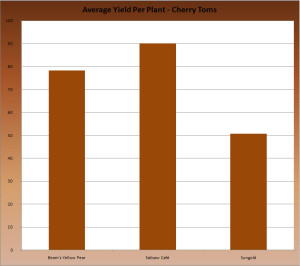
The average yield per plant was highest for Salisaw Cafe, and lowest for Sungold this season (click image to enlarge chart)
The Larger Heirlooms
Argentina:
This was an unexpected surprise. After spending some time in South America, we chose this variety just for fun. This is a late-season beefsteak type tomato, more deep pink in color than red, and it was fabulous. Excellent yields, second only to Black Pear (below), rich tomato flavor, and slightly acid, this tomato is simply gorgeous when sliced. If the cold weather set it back, it wasn’t noticeable, and fruit is still ripening on the vine. Plants are robust, and relatively pest and disease free. We’ll plant this variety again, if only to evaluate its performance during a more ‘normal’ summer here. (Mid-Season; Indeterminate)
Black Pear:
We grew this cool-season variety last year, because of its wonderful unique flavor, and it was our best performing tomato in regards to yield. This year however it initially seemed confounded with the weather, and some of the early fruits rotted before fully ripe. Subsequent fruit set was excellent though, and the per plant yields were the highest for this tomato compared to all others grown this year. It was a strong performer during last year’s excessive heat, and again this year in significantly cooler weather. Despite cool weather setbacks earlier this season, this variety is hardy, and prolific enough that it bounced back to out perform our other heirlooms. Still a favorite, this rich, slightly smoky flavored, crack-resistant variety will definitely be planted again. (Mid-Season; Indeterminate)
Cherokee Purple:
We grew this last year, and had good yields of modest sized fruits. This year however, Cherokee Purple was a relatively poor producer. We’ve had good years and bad years with this variety, but the good years are well worth the effort. However, it seems more sensitive to temperature fluctuations than some tomatoes, wanting heat, but not too much, and not overly tolerant of this year’s cold. Year over year, its unpredictable performance may cause us to consider an alternative for next season, in an attempt to find a variety that performs more reliably in our variable coastal climate. (Late-Season; Indeterminate)
German Red Strawberry:
We were so excited to try this oxheart variety, as we’ve never grown oxheart tomatoes here before. With this variety we had a little surprise. Some of the plants were indeed red oxheart tomatoes. However, German Red Strawberry, wasn’t always…red. Although some were red, one of the plants produced beautiful vivid orange fruits instead. The fruits were very large, oxheart shaped like their red counterparts, although the oxheart shape with both was variable, and sometimes lacking entirely. The orange variant looked more like Hachiya persimmons than strawberries.
The flavor of both was excellent though, sweet with a good tomato flavor. Presumably the orange was either a packaging error (there is a German Orange Strawberry variety), an errant cross, or perhaps a genetic variant. We don’t know, but we went ahead and saved seed all the same, as we found it to be a hardy tomato with better yields than it’s red cohort. Whether or not the saved seeds from the orange form will stay true to color next year remains to be seen. (Late-Season; Indeterminate)
Illini Star:
If there was a disaster in the tomato gardens this year, this was it. Illini Star was a bitter disappointment. This should have been a red, mid-sized, slicing sandwich tomato, similar to an Early Girl in both size and flavor. Very prone to tomato russet mite, and wilt, and well, overall a raggedy looking plant, whose branches would die back from the setting fruit clusters to the main stem, and the few small fruits produced mostly rotted, or split and molded, long before they were ripe. Definitely one to avoid here in the future, as there are too many other less disease-prone tomato varieties to try. (Mid-Season; Indeterminate)
Persimmon:
This was one of our favorites last year, but this year Persimmon was one of our poor performers. It seemed to resent our ‘June Gloom’ that started in May and extended all the way into the end of August. Fruit set was significantly lower this season, and many were either undersized, split, or rotting, especially around the shoulders, before they were ripe. Compare to Russian Persimmon below. (Mid-Season; Indeterminate).
Russian 117:
Another oxheart variety, Russian 117 produced some of the largest fruits of any variety we planted this year. Full of rich and complex tomato flavor, the fruits were a beautiful rich red color (unlike the German not-always-so-red Strawberry). Between the two oxheart varieties, this year at least, Russian 117 had better yield, flavor, and more consistent fruit size. (Late-Season; Indeterminate)
Russian Persimmon:
This variety was from an heirloom grown a few years ago from which we had saved seed. We grew this to compare it directly to the standard Persimmon (above), because we expected they may actually have been the same tomato. Comparing them side-by-side proved they are not. Russian Persimmon is less fluted in appearance, a deeper orange color, more resistant to disease, with higher yields, and superior flavor. We will definitely plant Russian Persimmon, over Persimmon, next year. (Mid-Season; Indeterminate)
Texas Star:
A beautiful yellow and pink bi-color beefsteak type tomato, with large fruits. We grew this variety as a replacement for Marvel Stripe, which had disappointing yields last year. Yield was much better with Texas Star than Marvel Stripe, although the fruits weren’t as large, but the tomatoes were just as beautiful when sliced, with a mild, sweet tomato flavor. (Late Season; Indeterminate)
Mystery Volunteer:
Based on the varieties grown here last year, we expect this mystery tomato was some sort of Persimmon cross. We had a few rogue tomatoes that popped up in the gardens this year, including this one that clearly must have slipped through the cold-compost pile, and found its way into the orchard. Regardless, once ripe, this monster was spied lurking near the pear trees. Completely neglected all season, except for gleaning some fertilizer or water from the orchard trees, this turned out to be a sizable monster, reasonably crack resistant, and flavorful. A fun find for a rogue volunteer!
Next year we hope to double the size of the tomato area of the garden, so we’ll have lots of room to try some additional varieties of tomatoes, including a few paste varieties. The keepers for this year are definitely Salisaw Cafe, Beam’s Yellow Pear, Argentina, Black Pear, and Russian 117. Off the list for next season however, hands down, Illini Star, and Sungold.
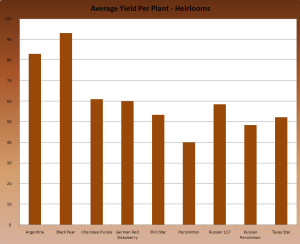
Despite cold summer temperatures, Black Pear was still our best yielding tomato this season (click image to enlarge chart)
Although in mid-August our tomato harvest outlook was looking bleak, once the weather warmed in September, we did end up with a reasonable harvest. The biggest issue this year, with the cool weather, seemed to be plenty of fruit-set early, but fruits were significantly slower to ripen, drastically shortening the overall harvest period. This is the first year that cherry tomatoes were just ready to harvest, alongside some of the late season beefsteak varieties. Although all were indeterminate, the shortened season made some varieties seem more determinate in nature. A very strange season indeed. Unfortunately, the errant weather this season has made it difficult to judge performance this year. Some varieties that previously have done well here, didn’t do well this season, and some new varieties were raging successes.
We’ll have to see what next year brings…

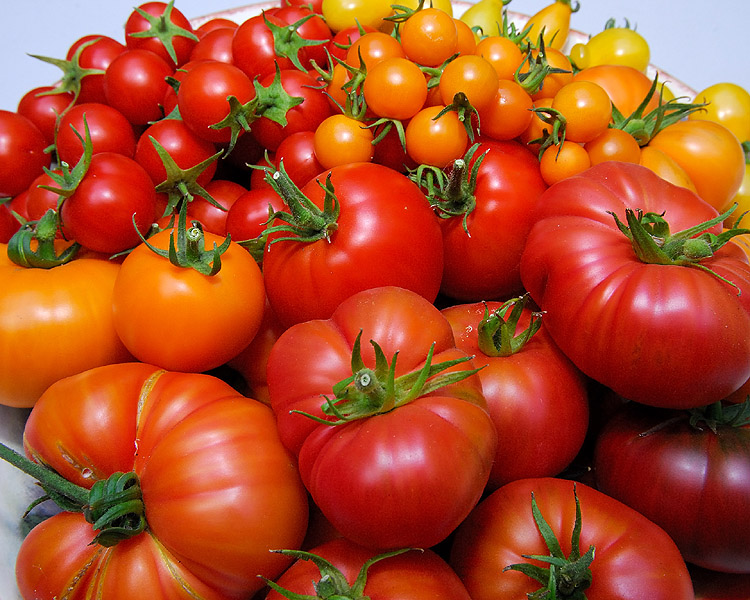
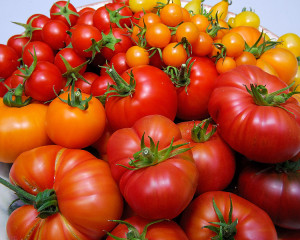


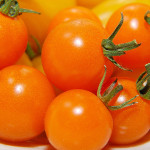

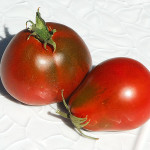
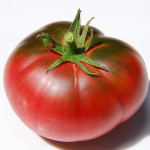
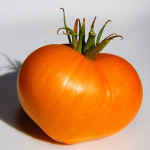
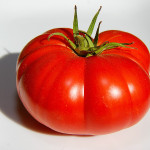
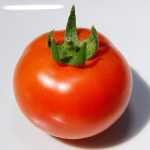
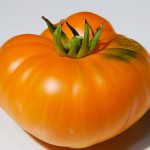

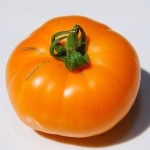
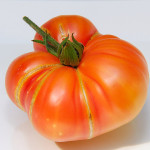
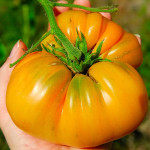
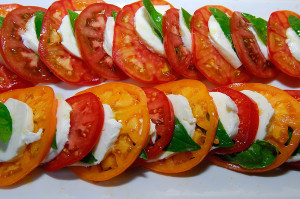







Thanks for the great tomato review! Our tomatoes performed miserably this year, with poor production, though most had great taste. The August heat did them in. Our Cherokee Purple produced only a few fruits. Sigh! We love fresh tomatoes, and now they are gone. Can’t stand those gassed things they sell in the grocery stores.
Agreed, the watery orbs in the supermarkets do not qualify as tomatoes in our book! 😛
That looks like a very good year to me! I had no luck at all.
Thanks for the review. I have tried so few varieties that I am always curious to see what others grow and how they do. I’m going to keep a few of yours in mind.
A great, thorough (of course!) review for tomato growing on the Central Coast! Thanks!
Great report! I am enamored with your Black Pear, because it is so pretty and it performed well too… Do you think it would be good for sauce? I am looking for something that is not boring and not super juicy, such as a standard old roma/paste, but better! What do you think?
I’m not sure that sauce made entirely with Black Pear would be ideal. The skins aren’t too thick, but it is a little more juicy/seedy than an average paste tomato. However, that said, it would be interesting to take a known good-quality paste type tomato, like Amish Paste or San Marzano, and add some of the Black Pear tomatoes to increase the flavor complexity. I might just have to try a sauce that way next year. 🙂
Wow what a fund of information! I’m with the “terrible year” people – all plant and hardly any tomatoes. I’ve a black thumb for tomatoes though – which really means an ignorant brain! I grow them in pots due to lack of fenced in areas for veggies, and thought I gave them all that it takes. But I didn’t, apparently!
We grew them in pots here up until this year, just because we didn’t have a deer-safe area to plant them. They certainly don’t perform as well in pots, in part I think because it’s difficult to regulate soil moisture, especially during some of our heat waves. Drip irrigation (or self-watering style) for the pots is a must in my opinion, mulch (like straw) to prevent excess moisture loss, and frequent fertilizer applications help them to do their best in pots. I also find cherry style tomatoes are more reliable in pots too, rather than the larger beefsteaks. Regardless, this year here on along the coast was a rough year for tomatoes all around.
That doesn’t look terrible at all and what a great variety. This is the first year we’ve had NO tomatoes other than a few grape tomatoes. I hope next year makes up for it.
I hope so too Catherine. We at least had a tomato harvest this year, but you should see our peppers! Well…maybe not 😛
I always learn so much that I never knew coming to you blog. I never realized their was such a variety of color and shape. I like the Cherokkee purple. They all look tasty.
Dear Clare, I can honestly say that I do not think that I ever really TASTED a tomato until I ate them in Budapest. I am so lucky that I can buy the most wonderful tomatoes of all sizes and colours year round at my nearby market. Your tomatoes remind me of them, they look wonderful and, I am sure taste delicious.
What an excellent report on your tomatoes! I stayed simple with just 2 varieties this year as I’ve just started a new veggie garden. Next year I intend to expand and this post will be extremely helpful when choosing what varieties I bring in. Thank you.
Great list Clare, my crop was so meager I’m relying on your list for next year’s plantings.
Here’s are my tomato picks, but this is from last year when the sun was obliged to show up:
http://tallcloverfarm.com/toms-tomato-tome-my-favorite-heirloom-tomatoes-for-2009
I have to say Tom, that Old German variety you grew in ’09 might end up on our list to try next year. It looks similar to Marvel Stripe and Texas Star that we’ve tried here, with the bi-colored flesh. A similar one that also looks promising is German Gold. Oh dear…too many choices!
Wow – what a fabulous tomato run-down! I must get me some cherry heirlooms for next year – my super sweet 100s were great this year though. Maybe do both and see who wins – like you did!
Clare you have grown quite an amazing list of tomatoes and some of them are quite a size aswell. There’s nothing quite like the taste of a homegrown tomato and my neighbour shares some of her crop with me in September each year. I have had so many disappointing crops in the past by growing them outside that I now just buy from the supermarket as I don’t have a greenhouse.
Yesterday I harvested what probably were the last ripe tomatoes.
My favorites this some where Black Cherry, a very tasty cherry tomatoe, and Erdies family Oxheart.
My expectations were high for Blue berry, but those were really disappointing, and Road Family heirloom was disappointing too.
(I had 19 varieties this year, the first year that I tried so many.)
Clare, great description of the tomatoes! thank you. I definitely will opt for the Salisaw Cafe next year over the Sweet 100, but our Sungold still performed beautifully this year and we do love that flavor.
Interesting is that the Cherokee was slow to produce in August and September here, but last week it went gangbusters whereas our Russian Black Krim underperformed compared to last year. Go figure, but I’m willing to give them a go again one more year.
Fun to compare notes Diana! I do recommend Salisaw, it did well for us here, although it’s amazing how some tomatoes do well in one place, and poorly in another. We’ll probably try Pineapple next year. We’re not sure about Old German though, it did well for Tom, but poorly for you. We’ll have to see if there’s room in the garden to try it next year.
Quite a variety…they all look so wonderful. All the data that you collected is very useful for you and others.
My data was easy to collect on one or two hands. It was my lack of experience that stop production pretty early. I have learned for next year.
While you had the coldest summer, we had the hottest summer in recent past. Really hot, above 90+F!
Great review! Black Pear is definitely on my list to try next year. The weather here also made it difficult to judge performance of our tomatoes. We did like the Flammes, which we grew for the first time, and the Amish Paste. Other heirlooms did little.
We might try Amish Paste along side something like San Marzano, that tends to do well here, and see how they perform side-by-side. Can’t believe we’re planning next year’s tomato garden already! 😛
I only grow them in the greenhouse because of tomato blight outdoors. Our crop was very poor this year – probably because we went on holiday and left the watering to my son – big mistake as there was a heatwave while we were away and a cool period when we got back. As you say tomatoes do not like temperature fluctuations (or lack of water!)
Your crop looks stupendous.
Great tomato round-up! I wish I could recommend a good paste variety for you. That is what I was going for this year, but neither the Amish Paste nor the Poland II have produced ANY ripe tomatoes yet. Very sad. Principe Borghese has a paste-like quality and it has produced nicely, but the fruits are small, like cherry tomatoes. What value is on your y-axis in the histograms of your tomato production? Is it pounds or number of fruit or ? If it’s pounds per plant, then you are the tomato queen!
Sorry, I seem to have misplaced my axis labels. Pounds per plant, I wish! No, overall yields were low this year, that was average yield per plant in ounces 😀
I can’t even handle this post. My tomatoes were pretty pathetic this year and I’m still bitter. Bitter is a yucky taste in your mouth when compared to gorgeous tomatoes! 🙂
I think you’re closer to the ocean than us. The only thing that saved our tomatoes at all is that once in a rare while, when downtown was fogged in, the sun peeked through the fog for an hour or two in the afternoon here. We are grateful to have had a harvest at all. Looking forward to a better year next year though.
Makes me hungry just looking at it. Luckily, my neighbor shared her tomatoes this year so I got my part of the bounty of the warm season.
I’m still glad I now have succulents in the pots where I first planted tomatoes…